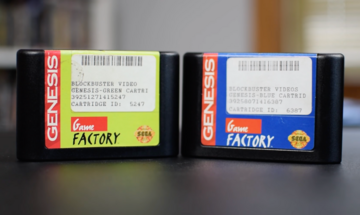Game Factory
From Sega Retro

| ||||||||||
| Game Factory | ||||||||||
|---|---|---|---|---|---|---|---|---|---|---|
| Made for: Sega Mega Drive | ||||||||||
| Manufacturer: NewLeaf Entertainment[1] | ||||||||||
| Licensor: Blockbuster | ||||||||||
| Type: Backup tool | ||||||||||
|
Game Factory was a rewritable Sega Mega Drive cartridge service run by Blockbuster around late 1994, developed through a collaboration between Sega of America and NewLeaf Entertainment.[1][2] A novel idea in the world of home rentals, the service was highly ambitious and critically well-received, but suffered from a number of problems and had its subsequent nationwide rollout eventually cancelled.[3]
Contents
Service
Manufactured by NewLeaf Entertainment subsidiary Fairway Technologies[1] exclusively for Blockbuster, two types of cartridge were offered; a green-labelled version (NL103) which could store up to 16 megabits, and a blue-labelled version (NL102) which could hold 32 megabits, both using a standard NTSC Genesis cartridge shell. A third cartridge, labelled with NewLeaf's logo (NL101) also exists, but appears not to have been intended for general consumers. Altogether, the process of flashing a cartridge with a new title took roughly 45 seconds.
Games available for rent through Game Factory appear to contain different ROMs than their original releases, with titles like The Jungle Book displaying a unique B.B. FLASH ROM message at the title screen to indicate its purpose.[4] The cartridges themselves use CR2032 batteries to preserve saved data.
List of rentable games
 |
This list is incomplete. The following list has been marked as incomplete. If you can, please complete it. |
History
Background
| “ | Game rental has become an increasingly important market segment, with estimates at about $1.5 billion a year industrywide. But with nearly 1,000 great Genesis and Game Gear software titles available, it’s tough keeping an inventory broad and deep enough to satisfy peak demand. This system ensures that every customer will be a satisfied customer. | „ |
In the early 1990s, the success of the Genesis and Super Nintendo in North America had resulted in the creation of a profitable video game rental market for Blockbuster. However, as technology continued to improve, the company was worried that upcoming systems of digital distribution (which could deliver movies and games directly to customer's homes) would negate the need for Blockbuster entirely, and looked to invest in new technologies to improve the customer rental experience.
The popularity of Blockbuster's game rentals also created the problem of inventory shortage, especially with certain hot-selling titles. Reportedly, one-third of customers were unable to rent their desired game due to it being unavailable. To address this issue, Blockbuster turned to the technology firm Soundsational, a company which produced networked music kiosks (at which customers could purchase an album and have it burned to CD or cassette while they waited. While Blockbuster's traditional fare of movies presented considerable technical hurdles in instant rewritability, video games were more compact in terms of filesize and distribution, and being able to utilize existing cartridge rewriting technology made the future-proofing of Blockbuster's game rental market an appealing investment.
Development
In 1990, Blockbuster acquired Soundsational, and at the same time teamed up with IBM to establish a sister company, Fairway Technologies. Soundsational was renamed NewLeaf Entertainment and assigned to both market the system and acquire licensing deals, while Fairway Technologies created the actual hardware, software, and networking technology. Over the next three years, the two firms set to developing a system of in-house flash cartridge writers for use in Blockbuster's rental stores.
The concept involved customers renting Mega Drive games stored on reprogrammable flash cartridges, and was chiefly pitched as an inventory management solution. Avoiding the need to stock potentially hundreds, if not thousands of official cartridges to rent, Blockbuster could instead use a Game Factory cartridge, flash the contents of a ROM image onto the memory inside, and meet the customer's request on-demand. Upon return, the cartridge could then be flashed with another ROM image and rented to another customer.[1] The green-labelled 16 megabit cartridge was originally produced as the system's only cartridge, but during development, Fairway Technologies was hit with the news that Spider-Man and Venom: Maximum Carnage (a game Blockbuster had signed up to promote) would be released on a 32 megabit cartridge, necessitating the need for a larger cartridge variant.
Blockbuster pitched the concept to both Nintendo of America and Sega of America. While the former replied with a hard no (as Nintendo was wary of game rentals, having famously taken Blockbuster to court over the matter), the latter was definitely interested, but wanted to see a proof of concept before licensing anything - resulting in Fairway Technologies having to virtually reverse-engineer the Mega Drive's cartridge technology to create a working demonstration unit. Thankfully, said demonstration was a success, and Sega granted NewLeaf a license to use several of its first-party games for rental through Game Factory.
Reportedly, a Game Gear variant was planned,[1] but does not appear to have been developed or advertised.
Launch
The Game Factory service was initially available between the 10th and 15th of August 1994[1] at ten Blockbuster stores in Columbia, South Carolina (alongside at least one store in NewLeaf's hometown of Boca Raton, Florida). The real plan, however, was to gauge interest in whether the concept would be feasible with the upcoming generation of consoles, namely the PlayStation and Saturn.
Decline
Though the market test was reportedly a success, Blockbuster chose not to follow through on a nationwide rollout for a number of reasons. Viacom's purchase of Blockbuster earlier that year had granted the company access to a larger pool of resources and financing, and this newfound safety diminished its need to invest in emerging technologies to stay profitable.
Blockbuster also encountered trouble signing deals with third-party publishers, and so could initially offer the service only for first-party Sega games[1] and those developed by Virgin Interactive (a company owned by Blockbuster). Eventually, Acclaim, Activision, and Parker Brothers all licensed titles for Game Factory, but by the start of 1995, Mega Drive sales were on the decline, and the rise of the significantly cheaper compact disc deterred companies away from further investment in cartridge technology. Coupled with the various anti-copy security features of disc-based games, Blockbuster chose to discontinue the service later that year.
After Game Factory's closure, the cartridges were generally flashed with a single game and sold directly to consumers as a form of liquidation,[6] frequently with the game's title crudely written on the label.[7] Cartridges which could not be liquidated at the store itself were shipped to other Blockbusters through standard inventory practices, resulting in former Game Factory cartridges appearing as far away as Flint, Michigan.[5]
Magazine articles
- Main article: Game Factory/Magazine articles.
Physical scans
External links
- Blockbuster Plays Into New Avenues, Software Is The Future For Entertainment Giant by Jeffery D. Zbar at Advertising Age
- Blockbuster, IBM announce multimedia ventures article at United Press International
- Blockbuster, IBM eye electronic inventories article by Matt Rothman at Variety
- Game Factory: Blockbuster & Sega's On-Demand Game Rentals video essay by Gaming Historian at YouTube
- Remember When Blockbuster Video Tried Burning Game Cartridges On Demand? article by Drew Littrell at Hackaday
References
- ↑ 1.0 1.1 1.2 1.3 1.4 1.5 1.6 1.7 EGM², "July 1994" (US; 1994-07-19), page 28
- ↑ 2.0 2.1 Sega Visions, "August/September 1994" (US; 1994-xx-xx), page 8
- ↑ https://www.youtube.com/watch?v=nrUWIHasHPQ (Ghostarchive)
- ↑ File:TheJungleBook MD US BBFLASHROM.jpeg
- ↑ 5.0 5.1 5.2 5.3 5.4 5.5 5.6 https://docs.google.com/spreadsheets/d/1pOsHrcfrjqzgSbIXidj0JfLqgWX-ftIczHX0VcPUcV0/edit?usp=sharing
- ↑ https://www.youtube.com/watch?v=nrUWIHasHPQ
- ↑ https://drive.google.com/file/d/1KrzXK094OdgcxpcSw6oTspZ65TsaUgaf/view
